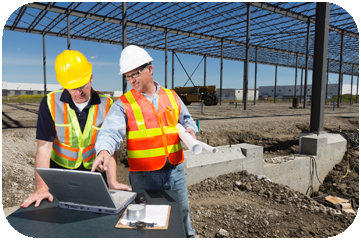Civil Geotechnical Engineering Solutions for Commercial and Residential Projects
Civil Geotechnical Engineering Solutions for Commercial and Residential Projects
Blog Article
Exactly How Consulting Engineers Enhance Geotechnical Design Projects: Insights Into Their Proficiency, Approaches, and Collaborative Approaches
Consulting designers are crucial in boosting geotechnical engineering projects, using their specialized knowledge to browse the complexities of subsurface conditions. Their joint approaches foster communication amongst diverse task stakeholders, eventually forming the project's trajectory.
Function of Consulting Engineers
The proficiency of seeking advice from designers in geotechnical design is fundamental to the successful execution of building jobs. These specialists play an essential duty in assessing dirt and rock homes, which are important variables affecting style and building and construction decisions. By conducting complete site investigations, getting in touch with engineers gather necessary data that educates the design procedure, making sure tasks are improved stable and suitable ground.
Consulting engineers likewise offer very useful insights right into threat administration (geotechnical geologist). They identify prospective geotechnical hazards, such as landslides, dirt liquefaction, and settlement issues, enabling stakeholders to apply efficient mitigation strategies. Their experience aids in maximizing foundation designs, which can bring about considerable cost financial savings and boosted safety and security
Furthermore, getting in touch with engineers work as an essential web link in between project owners, architects, and service providers. Their capability to equate complex geotechnical data into actionable recommendations promotes cooperation and promotes informed decision-making throughout the job lifecycle. This multidisciplinary strategy not just boosts project efficiency yet additionally makes certain compliance with regulative requirements and finest practices.
Trick Methods in Geotechnical Engineering

One primary approach is site investigation, which includes carrying out area tests and lab analyses to gather information on subsurface conditions. Strategies such as Criterion Infiltration Screening (SPT) and Cone Penetration Testing (CPT) are extensively used to examine soil stratigraphy and strength. In addition, geophysical approaches, consisting of seismic and electric resistivity studies, offer non-invasive means to evaluate subsurface features.
An additional critical technique is mathematical modeling, which enables designers to simulate numerous circumstances and predict just how soil-structure interactions will act under various loading conditions. Limited Component Evaluation (FEA) is a typical technique utilized in this context.
Additionally, the style of foundations, retaining structures, and earthworks counts greatly on these methods - geotechnical geologist. By incorporating sophisticated logical devices with field information, speaking with engineers can create tailored services that deal with particular job obstacles, ultimately adding to the stability and security of building and construction projects
Significance of Dirt Analysis
Dirt analysis functions as a foundational aspect in geotechnical design, giving crucial understandings into the physical and chemical homes of dirt needed for effective building planning. Recognizing dirt attributes is essential for establishing its load-bearing capacity, drain actions, and possibility for settlement or instability. Detailed soil examinations, including tasting and research laboratory screening, help determine criteria such as soil type, moisture content, thickness, and shear toughness.
These analyses educate the choice of suitable building techniques and products, inevitably affecting job security and long life. As an example, natural dirts may call for various structure styles contrasted to granular dirts, requiring customized engineering options. Dirt analysis aids in recognizing impurities that might position threats to human wellness or the environment, enabling for the growth of mitigation techniques.
Integrating soil evaluation into the very early phases of job growth aids to lessen unexpected difficulties, guaranteeing that designers can prepare for and attend to potential problems before they rise. By developing a comprehensive understanding of the website problems, consulting designers can maximize layout performance and reduce expenses, consequently improving the overall success of geotechnical design projects.
Collaborative Techniques in Projects
Successful geotechnical projects commonly depend upon joint approaches that unite varied competence from various techniques. Efficient cooperation amongst getting in touch with designers, geologists, environmental researchers, and building specialists is vital for addressing complicated difficulties and optimizing job end results. By leveraging the distinct skills and knowledge of each team participant, jobs why not try this out can take advantage of an alternative understanding of the site problems, regulative requirements, and engineering constraints.
Routine interaction and interdisciplinary meetings assist in the sharing of insights and promote a society of teamwork. These joint efforts make it possible for the recognition of possible threats early in the project lifecycle, permitting timely reduction approaches. Furthermore, integrating comments from stakeholders, consisting of neighborhood communities and regulatory agencies, ensures that all viewpoints are thought about, enhancing project approval and conformity.
In addition, the combination of sophisticated modern technologies, such as Geographic Details Systems (GIS) and Structure Info Modeling (BIM), additional improves cooperation. These tools enable for the real-time sharing of information and visualization of geotechnical problems, promoting informed decision-making. Eventually, a joint technique not only improves job implementation yet likewise lays the foundation for innovative solutions to intricate geotechnical engineering challenges.
Impact on Job End Results

Consulting designers use advanced methods such as threat analysis and anticipating modeling, which boost the precision of project forecasts. Their capability to incorporate innovative technologies, like geotechnical instrumentation and information analytics, additionally improves the style and construction procedures. Because of this, jobs experience improved performance, reduced expenses, and lessened delays.
Furthermore, cultivating reliable communication and partnership among employee boosts problem-solving abilities. When difficulties emerge, a joined front permits quick recognition of services, avoiding possible troubles. Ultimately, the collaborative initiatives of speaking with designers add to better results, making certain visit this page that jobs meet both governing criteria and client expectations.
Conclusion

Report this page